|
敬请期待中文版 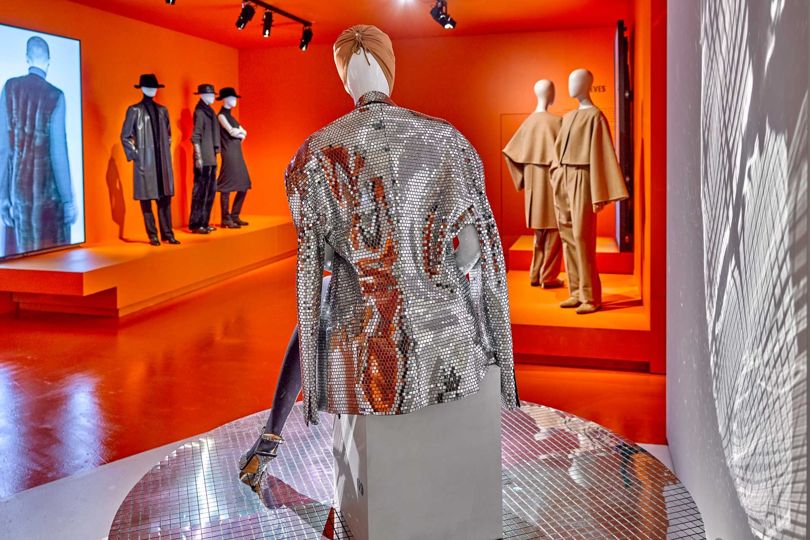 A Maison Margiela mirrorball-effect jacket Stany Dederen The first thing I asked Martin Margiela – so reclusive during his design career and so silent since he left the fashion stage 10 years ago – was why this exhibition in his native Belgium was taking place? And why the focus on his seven years at Hermès, the noble French fashion house, where for the last 14 years Margiela’s designs have been waiting, silent on their hangers, in the Hermès cold storage room? 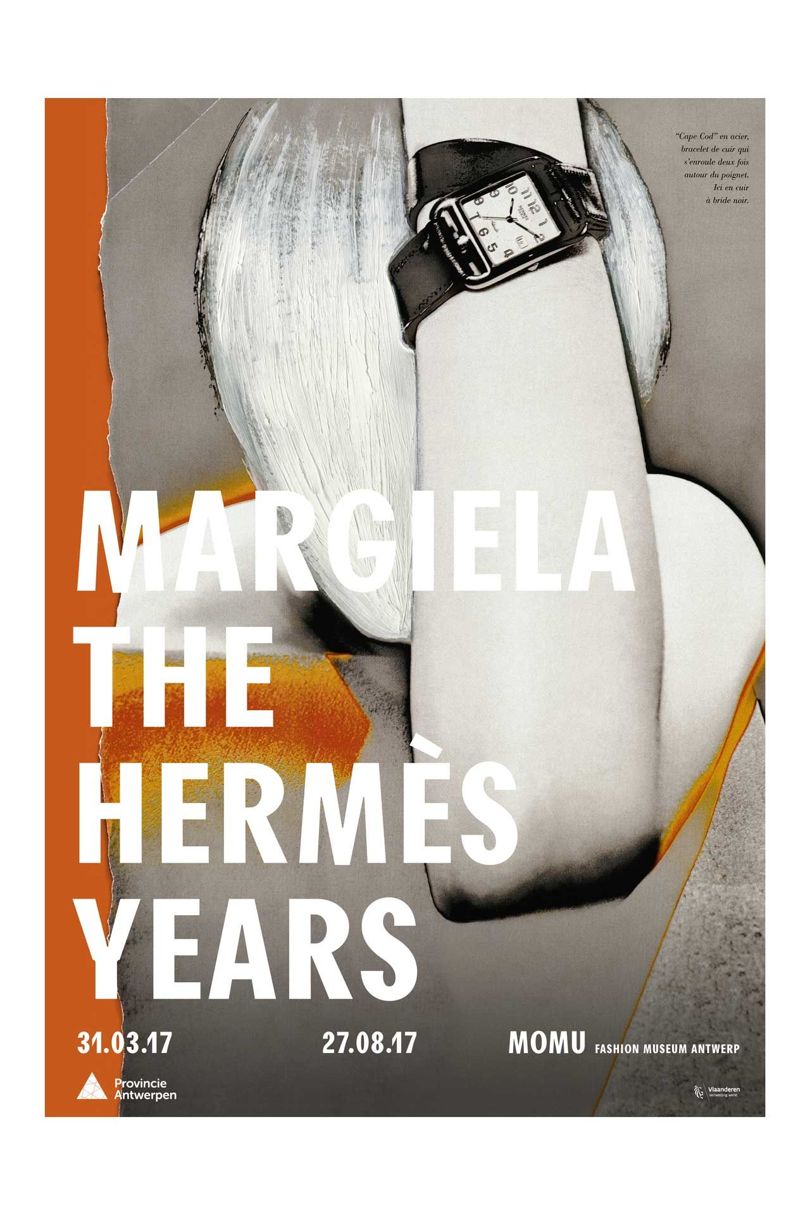 The poster for the new Margiela exhibition at MoMu in Antwerp MoMu “The memory was lost,” the designer said, explaining that his Hermès period was just before the new millennium ushered widespread use of the Internet and smartphones to record every fashion event. Now, the memory of the Hermès years is marked forever in a powerful evaluation of Margiela from his arrival on the fashion scene at the end of the extravagant 1980s; his stand-off for decent, modern women against the super-sexed version of femininity at Tom Ford’s Gucci; and then the elegant fluidity of Hermès.  Margiela's interest in the shoulder line, and a fluid oversize silhouette (right), which he explored at Maison Margiela (right), resurfaced in sophisticated form for Hermès (left) Stany Dederen 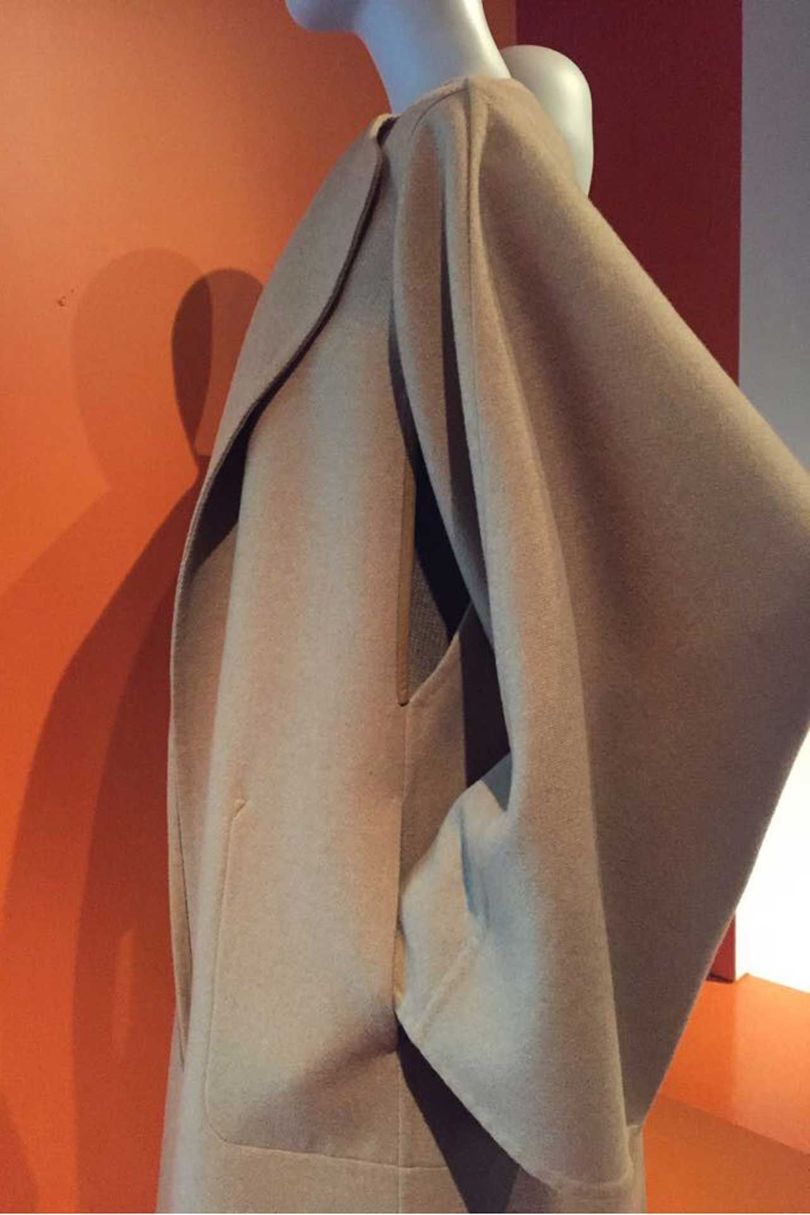 A camel coat by Martin Margiela for Hermès, showcasing his fluid drapery and love of hidden details, such as the slit in the underarm to enable ease of movement and, if the arms are put inside the opening, to wear the coat as a cape @SuzyMenkesVogue “Fluid is a word we often used – it had to hang off the body,” said the designer, showing me the layers of camel cashmere flowing across the figure, arms slipping in and out of secret places. Then he explained the famous “vareuse” – a quintessentially French word for top halves, cut so that the V-neck plunges downwards without ever revealing more than is elegant. 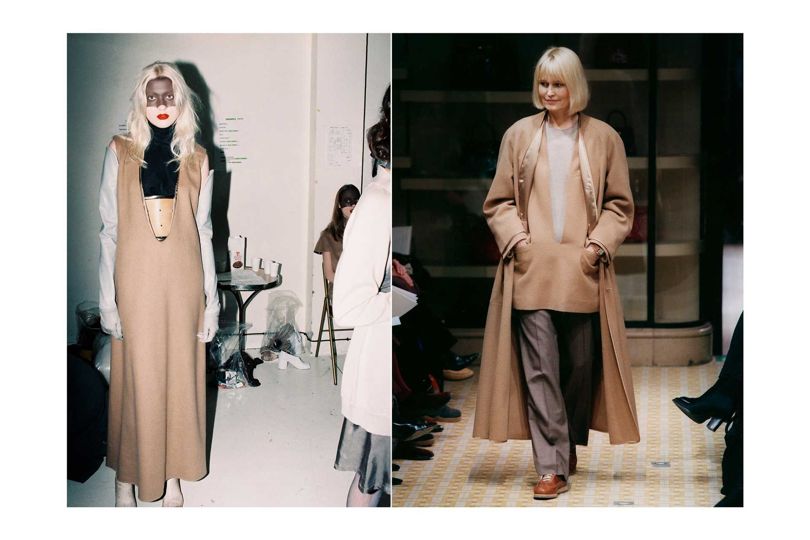 Left, Maison Martin Margiela A/W 1996-1997; right, Martin Marigela for Hermès A/W 1998-1999 Anders Erdström (left)/Studio des Fleurs (right) And then Margiela, dressed in a mustard-beige sweater and white jeans, showed me his secret signature at Hermès – something that I had never absorbed, even though I saw all the presentations for the Paris house, as well as the designer’s early, more radical shows. The most famous took place in the scrubby open land on the outskirts of Paris where the models’ clothes were wrapped in plastic dry cleaning bags and the neighbourhood kids came to stare, laugh and ultimately to watch the show with us. In Margiela’s hand was a cuff with the buttons sewn on with six, instead of four, holes. The resulting flourish was a pattern that read “H” for Hermès. “Margiela: The Hermès years” at the MoMu Fashion Museum in Antwerp (from 31st March until 27th August) is a triumph for Kaat Debo, Director of MoMu and the exhibition’s curator. Her intelligence, visual imagination and deep understanding of Margiela and his work shines an unflinching light on all the designer’s creations in the two worlds she sees through the glow of Hermès orange and the chill of white. The latter was the designer’s trademark for his whitewashed studio, its furniture, its chiffon-covered chandeliers, and the lab coats for his staff. “You enter the exhibition and the idea is to have both worlds of Martin – Maison Martin Margiela and Hermès – next to each other,” the curator said. “You have literally the orange world and the white world – you even see them hand painted on tailors’ dummies.” 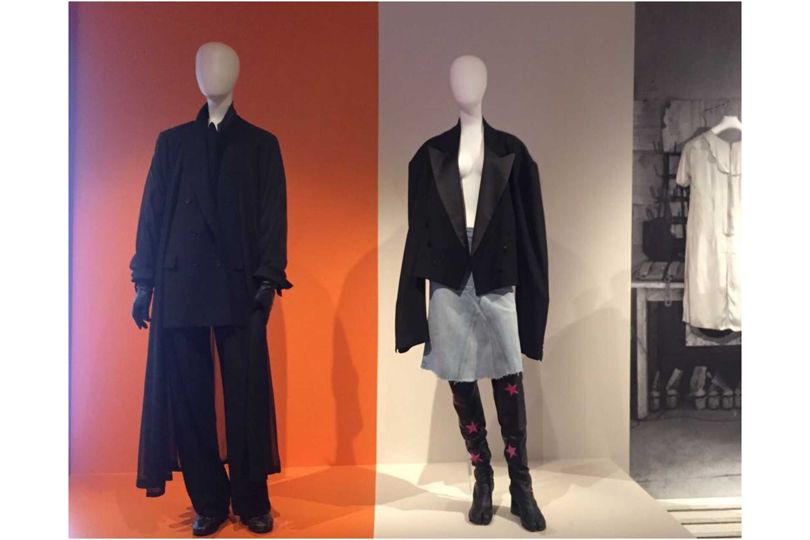 The exhibition reveals Margiela's work for Hermès (against the house orange colour) juxtaposed with his designs for Maison Margiela (whose studios were a palace of white) @SuzyMenkesVogue What you do not see is any reference to the Maison Margiela of today, which is designed by John Galliano, although in our long private conversation over lunch in the Belgian city, where everyone in the fashion world runs into each other, Margiela said that he had met up with his successor. The exhibition starts with a piece of music, with a man's voice tenderly listing, in alphabetical order, French compliments to women. It was played at two of the Hermès collections in the historic store in the rue du Faubourg Saint Honoré in Paris. “I wanted to have it at the start of the exhibition so that all women pass through a shower of compliments,” Kaat said. “I think it illustrates the respect for women that is in Martin’s entire body of work for Hermès.” 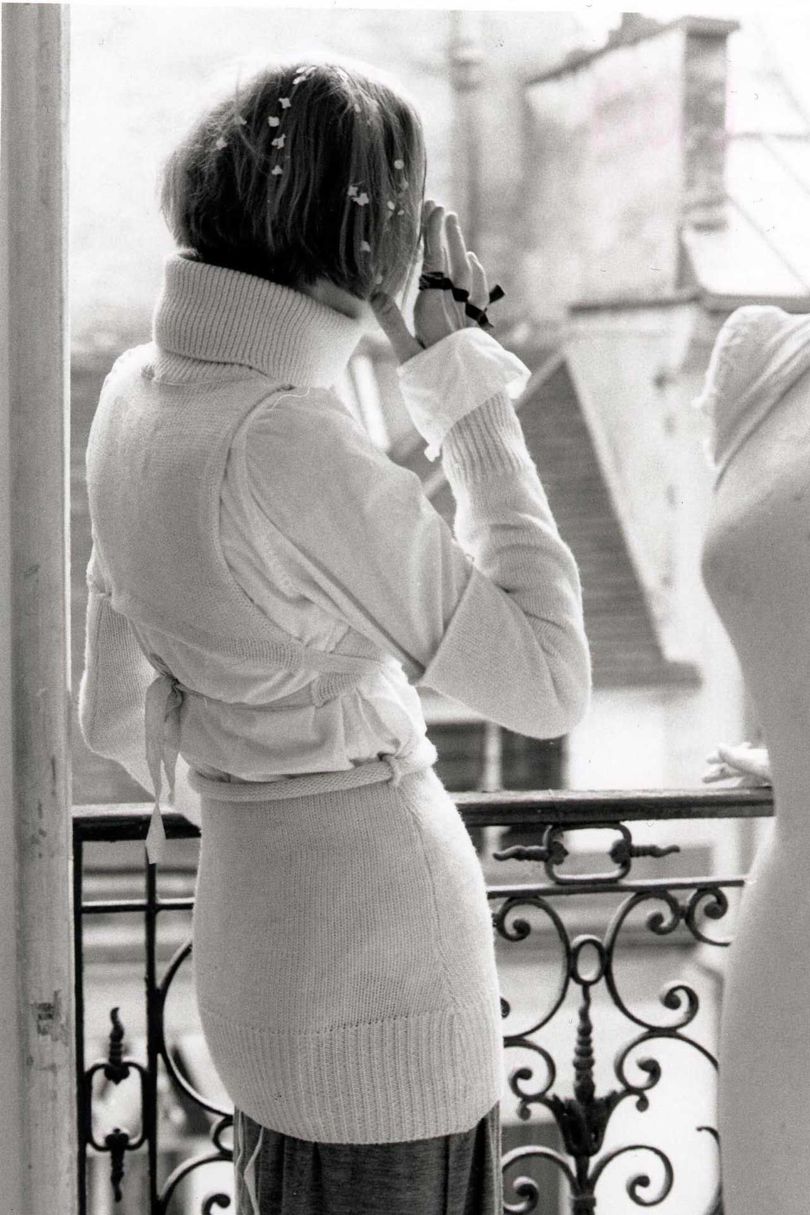 Maison Martin Margiela A/W 1991-1992 Marina Faust The show opens with a display of different body shapes from the two separate companies – especially the soft, long, unstructured silhouette for Hermès, with no shoulder pads, like “a Japanese way of working with garments”, according to Kaat. The problem with Margiela’s Hermès shows, which took place during his tenure as Creative Director of womenswear between 1997 and 2003, was that they were so subtle that they were not always easy to appreciate, even in movement. But Kaat and Martin had the idea of making mini-films of customers – mostly now, as the French say, “of a certain age” – to emphasise the liquidity and adaptability of the clothes as the women wearing them move about. 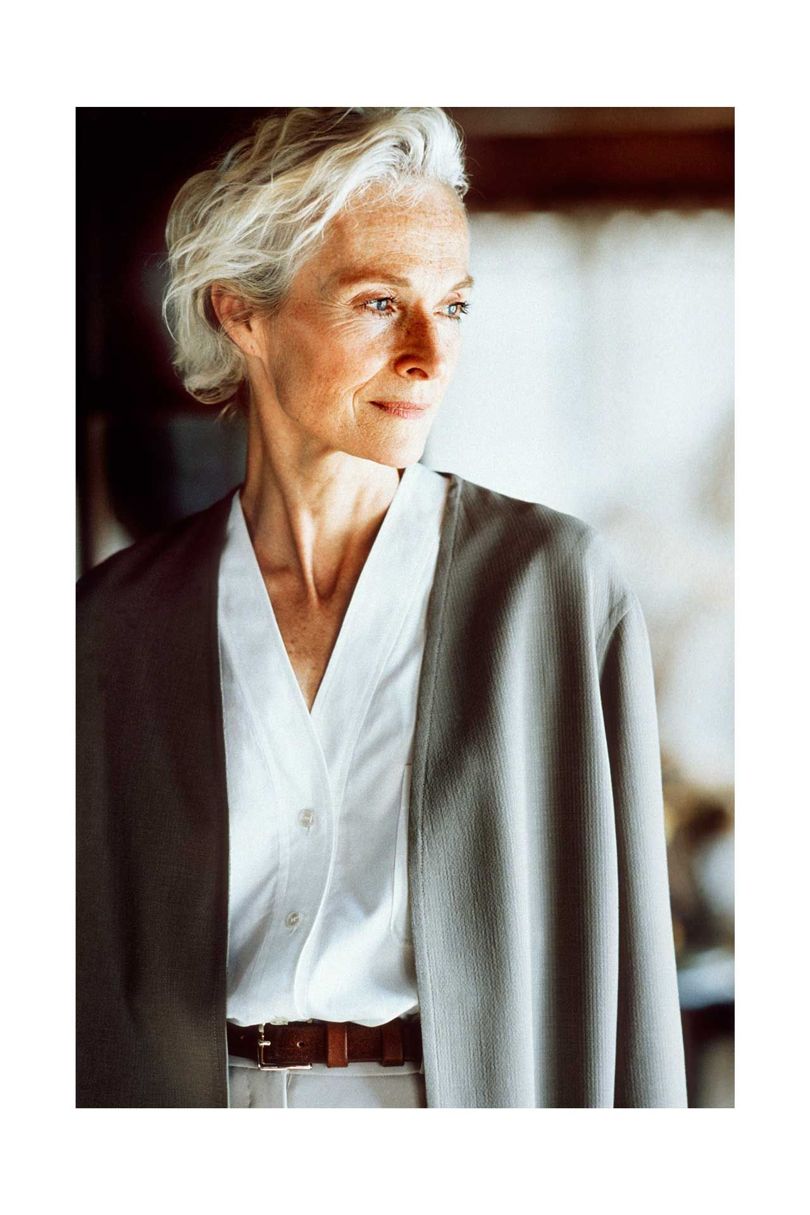 Martin Margiela for Hermès S/S 1999: Cardigan in doube-faced crêpe, collarless shirt in Oxford, pants in crêpe and belt ‘Étrivière’ in bridle leather, "Le Monde d’Hermès" Serge Guerand This was in contrast to the house of Maison Martin Margiela, founded in 1988 with his great supporter and business partner Jenny Meirens, after the designer had left Jean Paul Gaultier, where he worked from 1985-1987. The Gaultier years, although not a subject of this show, were crucial in giving the designer a backbone of cutting and draping for his entire career. 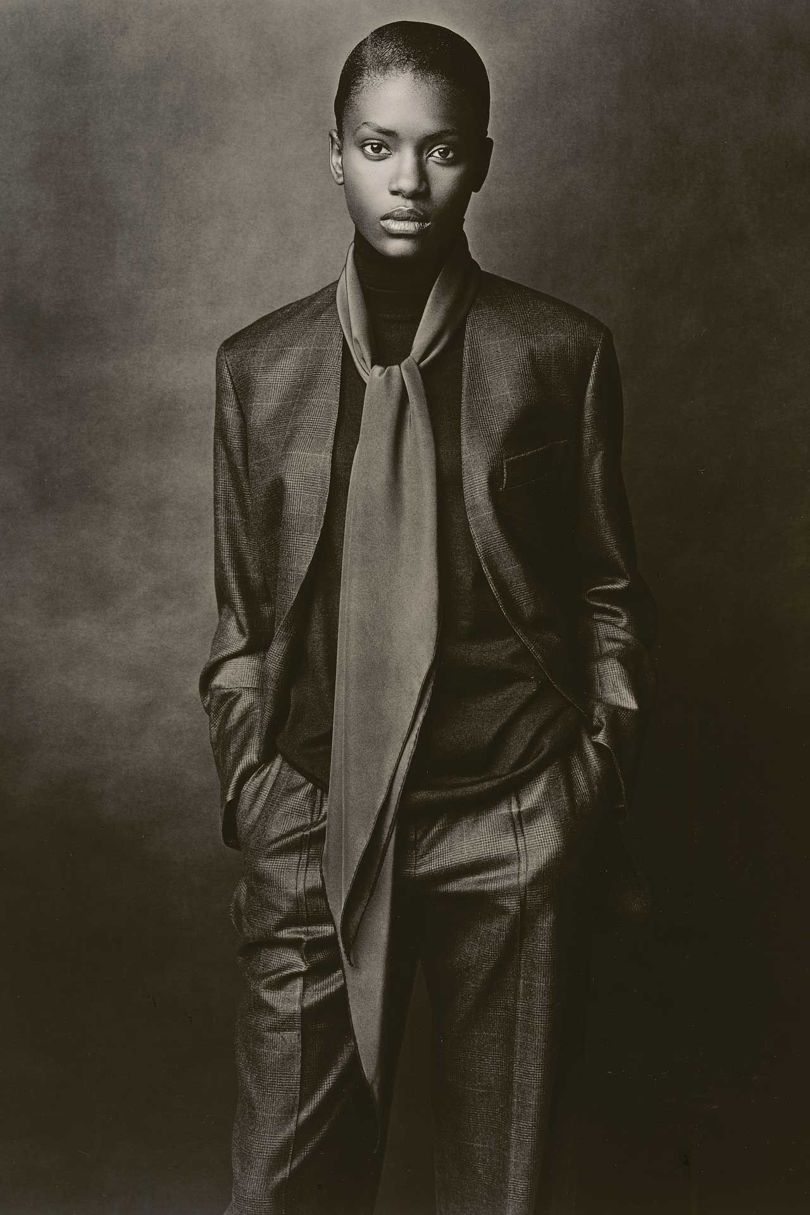 Martin Margiela for Hermès A/W 2001-2002: Collarless jacket and pants in cashmere and silk, high-neck pullover in cashmere and silk, scarf ‘Losange’ in silk crêpe, 'Le Monde d’Hermès' Ralph Mecke Margiela’s concept was often based on deconstruction, which is why he was known in the 1990s as an iconoclast. But the lines of his own brand and of Hermès were really parallel, a fact that is brought out effectively in the museum show. Margiela explained his Hermès thought process to me: how a precious leather coat would be given a protective cover, which I assumed to be plastic, but was actually made of chiffon; how sleeve linings were pure silk; and how a raincoat in camel hair allowed you to put your arms through the holes so that the garment could oscillate between cape and jacket. Even the Hermès branding was subtly changed. “I thought with timeless clothes that the label had to be something timeless as well, so I said, ‘Do you want a label that says Hermès Paris?’” Margiela said, explaining that the “new” logo was, in fact, a vintage 1970s Hermès Paris label he had found on a leather glove. Such a bold step in a heritage house was accepted by the late Jean-Louis Dumas, the CEO of Hermès, whose daughter introduced Margiela to her father after modelling for the designer. Pierre-Alexis Dumas, Jean-Louis’ son and the current Artistic Director of Hermès, remembers the subtle takeover in 1998 of the house’s designer collective, which had included among others, Marc Audibet and Thomas Maier. At that time, ready-to-wear represented only 13% of the Hermès turnover and Pierre-Alexis says that his father never took Hermès for granted and knew that he was stepping into the unknown by choosing Margiela. 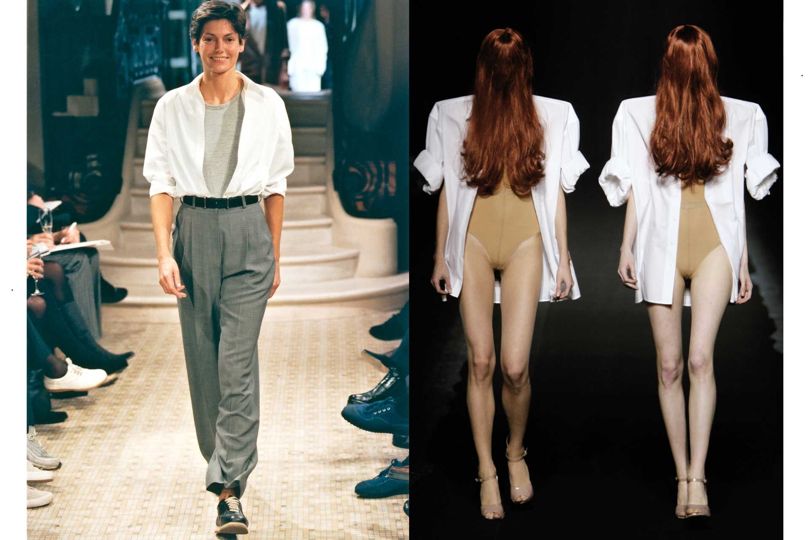 Left, Martin Margiela for Hermès S/S 1999; right, Maison Martin Margiela S/S 2009 Studio des Fleurs (left); Giovanni Giannoni (right) “My father expressed that in his own visionary way,” said his son, quoting a powerful statement from Jean-Louis: “Martin is invisible - but it is like oxygen, invisible but vital. It is a new shoot in a branch that has already been growing for half a century. Martin is not a cuckoo bird nesting in the leaves of Hermès. On the contrary, he brings a new vision to what we are.” It is to the credit of the curator that she has shown the Hermès clothes so intelligently in tandem with Margiela’s own: one against an orange backdrop and the other against white, making both seem relevant and timeless in their different ways. That is with the exception of a jacket with mighty shoulders, looking like a current piece from the much-discussed Vetements brand (whose designer Demna Gvasalia worked with Margiela). “Shoulders are important for Martin because in his collections the shoulder really is a structuring element,” said Kaat. “But what is really important to me is that these are not entirely divergent worlds. One creates the DNA and the ideas and techniques keep coming back. But I think also of the overall vision of Martin, resisting the fashion system, resisting some of the obsessions like the ideal body, eternal youth, constant innovation and renewal. At Maison Martin Margiela he resisted in a very conceptual way. And at Hermès, it was this slowly evolving wardrobe. That’s why the garments are conceived and designed as transportable – you can wear them in two or three different ways. For me it is ‘slow’ fashion before the concept even existed.” 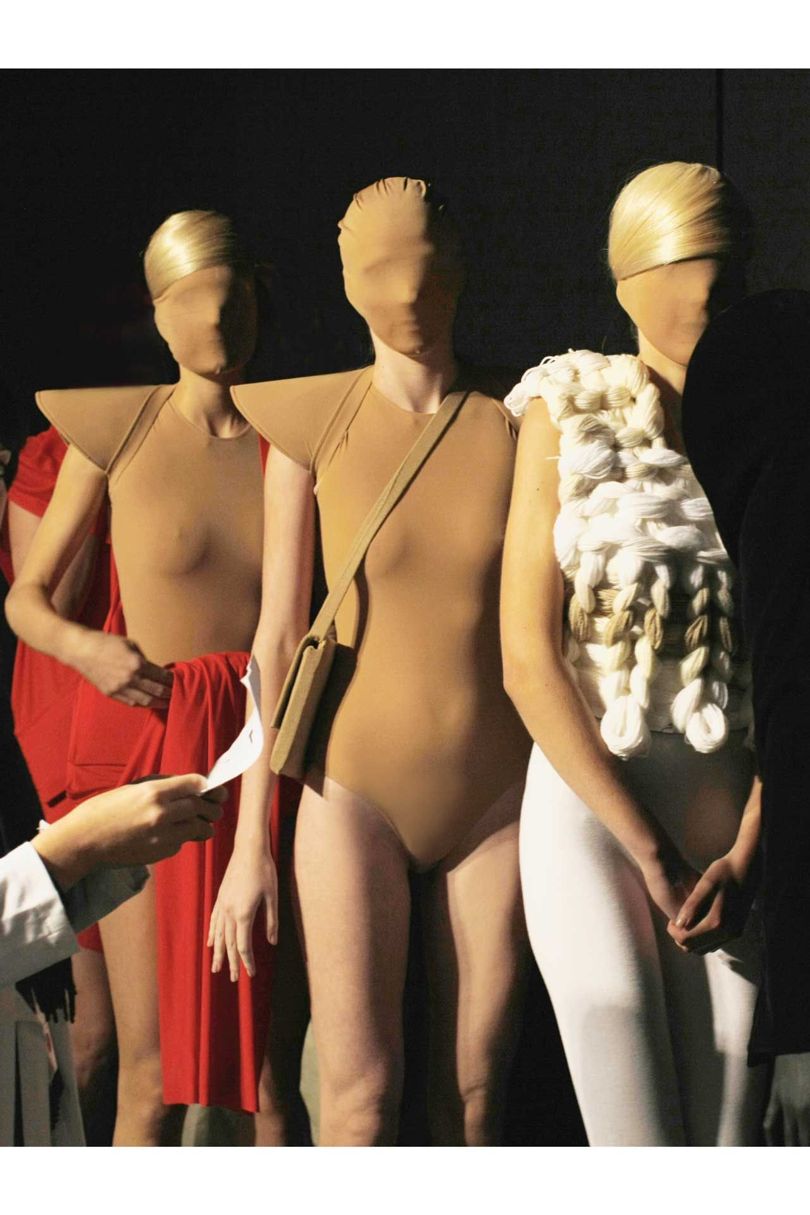 Maison Martin Margiela S/S 2009 Marina Faust Kaat showed me Margiela’s play with openings that enabled garments to be used in divergent ways. And many of the outfits – say classic trench coats – might belong to each category, even if the Margiela version had a pair of nylon stockings as a belt. There was even a “trikini” – a three-piece bikini worn across the body in separate bands, so that its wearer could choose her level of exposure. According to Pierre-Alexis, Margiela underlined the key values that he was using to define his work for Hermès: ease, comfort, quality - and time. And that Jean-Louis thought that the designer’s biggest innovation was to go beyond “reconciled” ideas.  Martin Margiela for Hermès A/W 1998-1999: Vareuse in double-faced cashmere, sleeveless high-neck pullover in cashmere, mid-length skirt in Shetland wool and boots in calfskin, ‘Le vêtement comme manière de vivre’ for 'Le Monde d’Hermès' John Midgley “He was always telling me that Hermès needs to change all the time in order to remain true to it spirit," Pierre-Alexis Dumas remembers. "Margiela intrigued him – he was seduced by the deep insights and the discreetly subversive approach with practical intelligence. Above all, he liked Martin’s thought process, the delicate yet determined way he had to follow his ideas all the way through.” 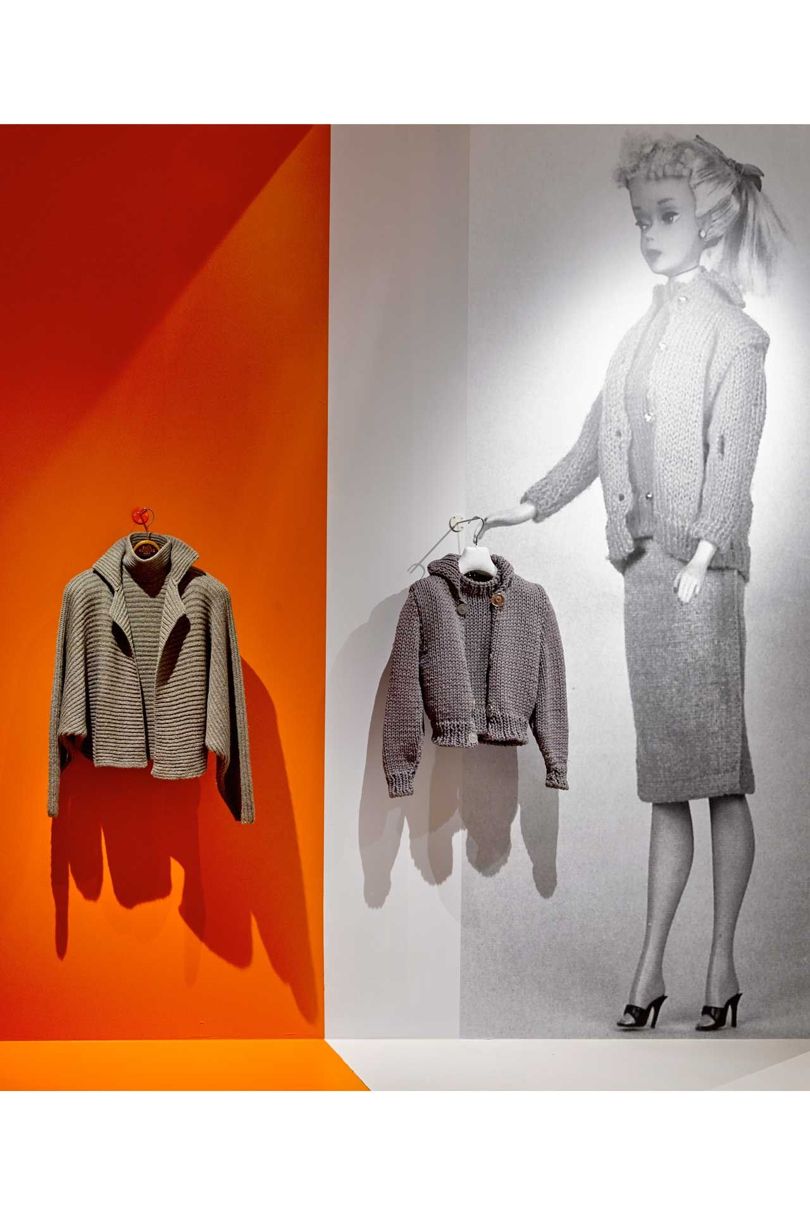 Martin Margiela for Hermes (left) and for Maison Margiela (right, as modelled by Barbie) Stany Dederen In the final section of the MoMu show, beside Hermès classics, is a bag by Margiela where the strap can be wrapped around the hand. That matches the Cape Cod watch with its double strap and the daring introduction of trainers to Hermès’ shoe collection. I was fascinated to learn from Pierre-Alexis that the mysterious Margiela communicated only by fax but seemed to have a sixth sense about design. The current Hermès designer, Nadège Vanhee-Cybulski was actually trained at Maison Martin Margiela and is following in his footsteps in making classy clothes of multiple use. Like her mentor, she is accused by some of being dull – but she should probably take that as a compliment. 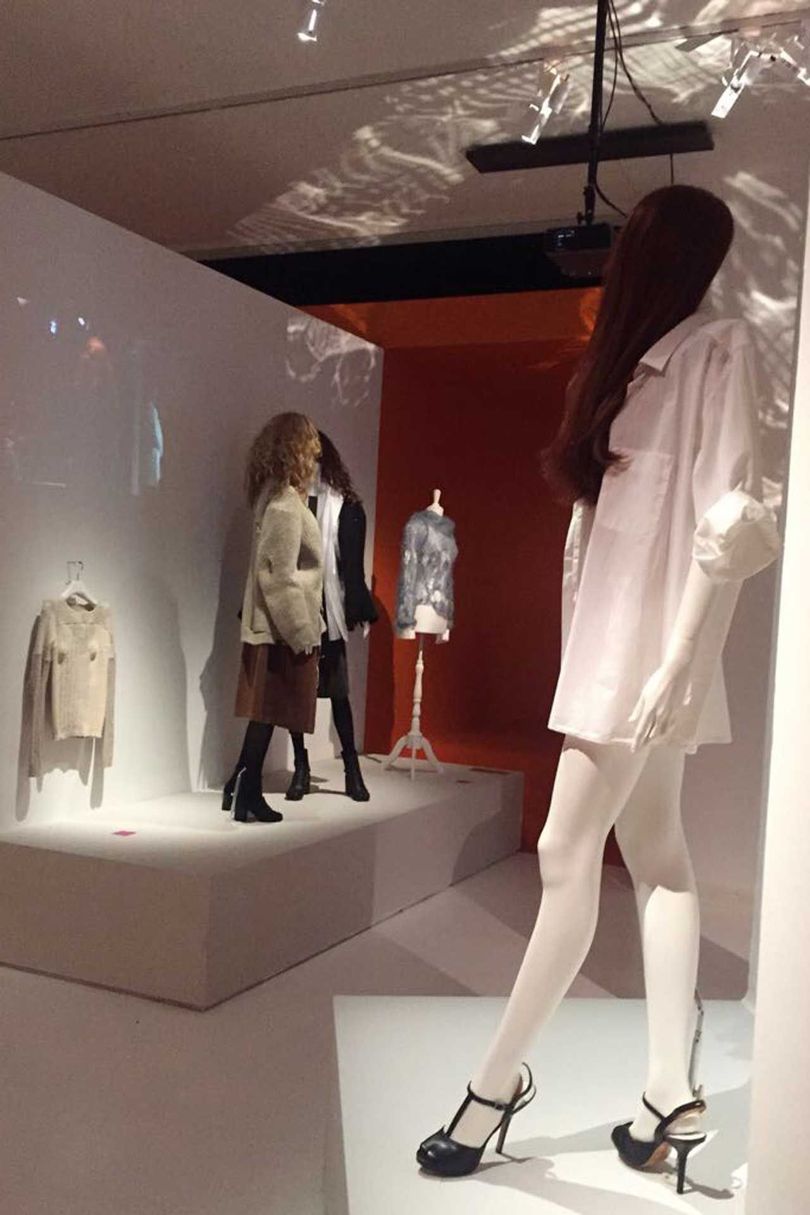 Displays at the new Martin Margiela exhibition at MoMu in Antwerp @SuzyMenkesVogue “I wanted to be boring in a certain way,” says Margiela. “I was working for a small number of women and then that became bigger and bigger.” Occasionally, the designer says, he will come across one of his outfits, like the fur coat he saw recently in a Paris restaurant. Nothing from the Hermès collections looks dated or out of synch with the times. Margiela, who turns 60 in April, sold his company to Renzo Rosso, founder of Diesel and President of the OTB Group, and then bowed out to concentrate on his painting. The designer has an explanation for timeless fashion. “I think the older you get the more you understand – man or woman – what suits him and her and makes them happy to wear. This is something that comes with age. You want it to last. Before, I would never buy three colours or three shades of the same sweater - but today I will!”  Martin Margiela for Hermès A/W 1998: the advertising campaign, over-painted by Martin Margiela, showing the Cape Cod watch designed by Henri d’Origny with the double-tour strap bracelet created by Martin Margiela. Photo: Thierry Le Goues 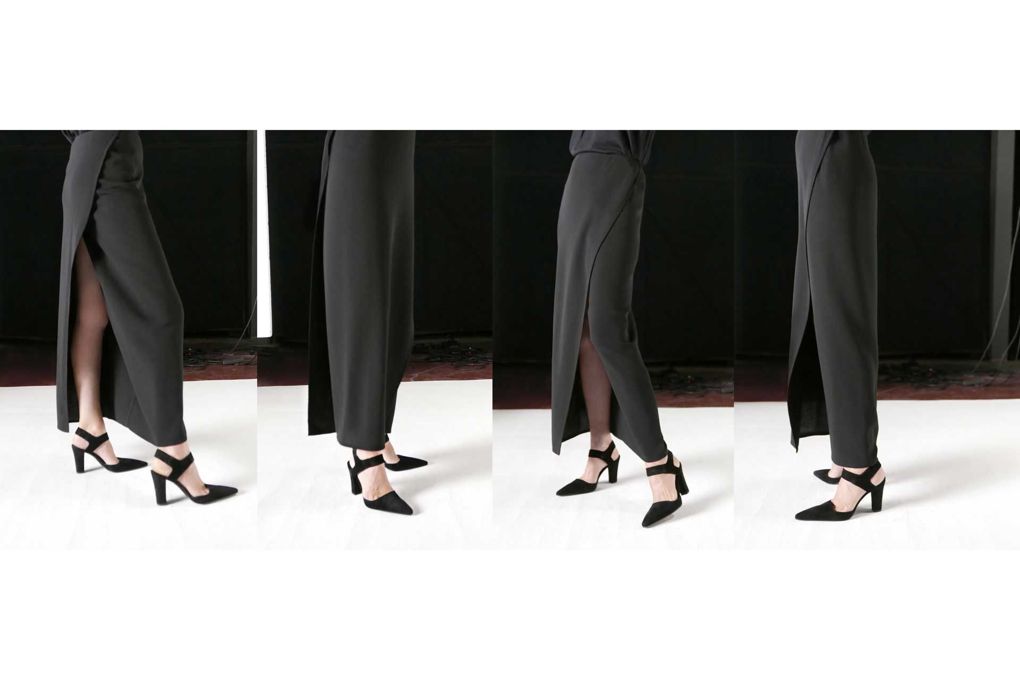 Martin Margiela for Hermès A/W 2001-2002: ‘Jupe enroulée’ from ‘Les Gestuelles’. Photo: Marina Faust Credit Marina Faust 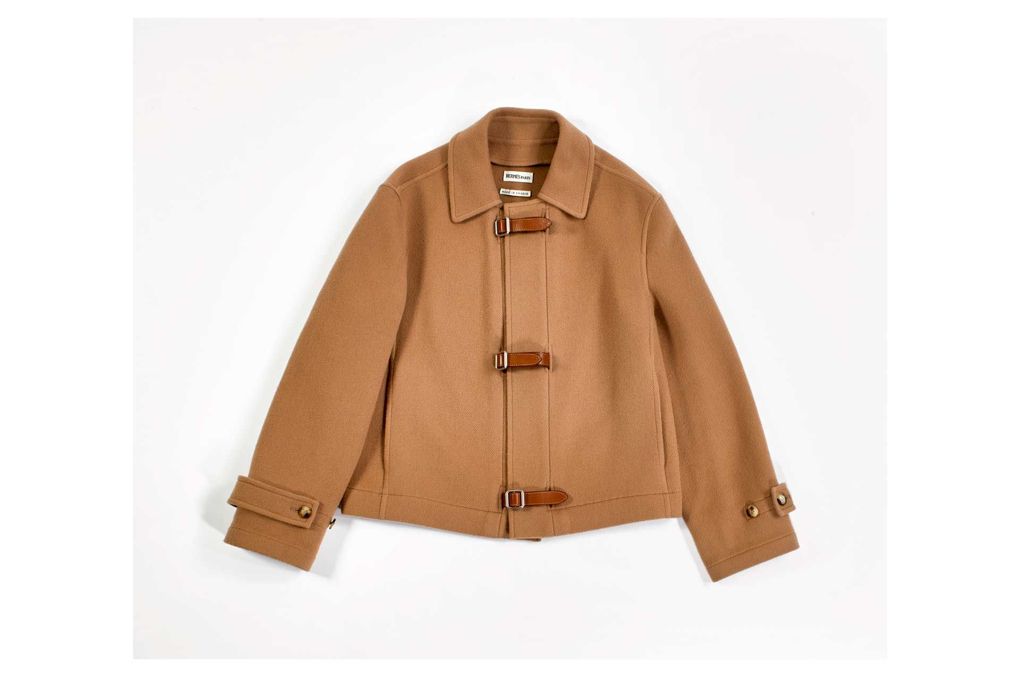 Martin Margiela for Hermès A/W 2000-2001: ‘Les Transformables’ jacket. Photo: Stany Dederen 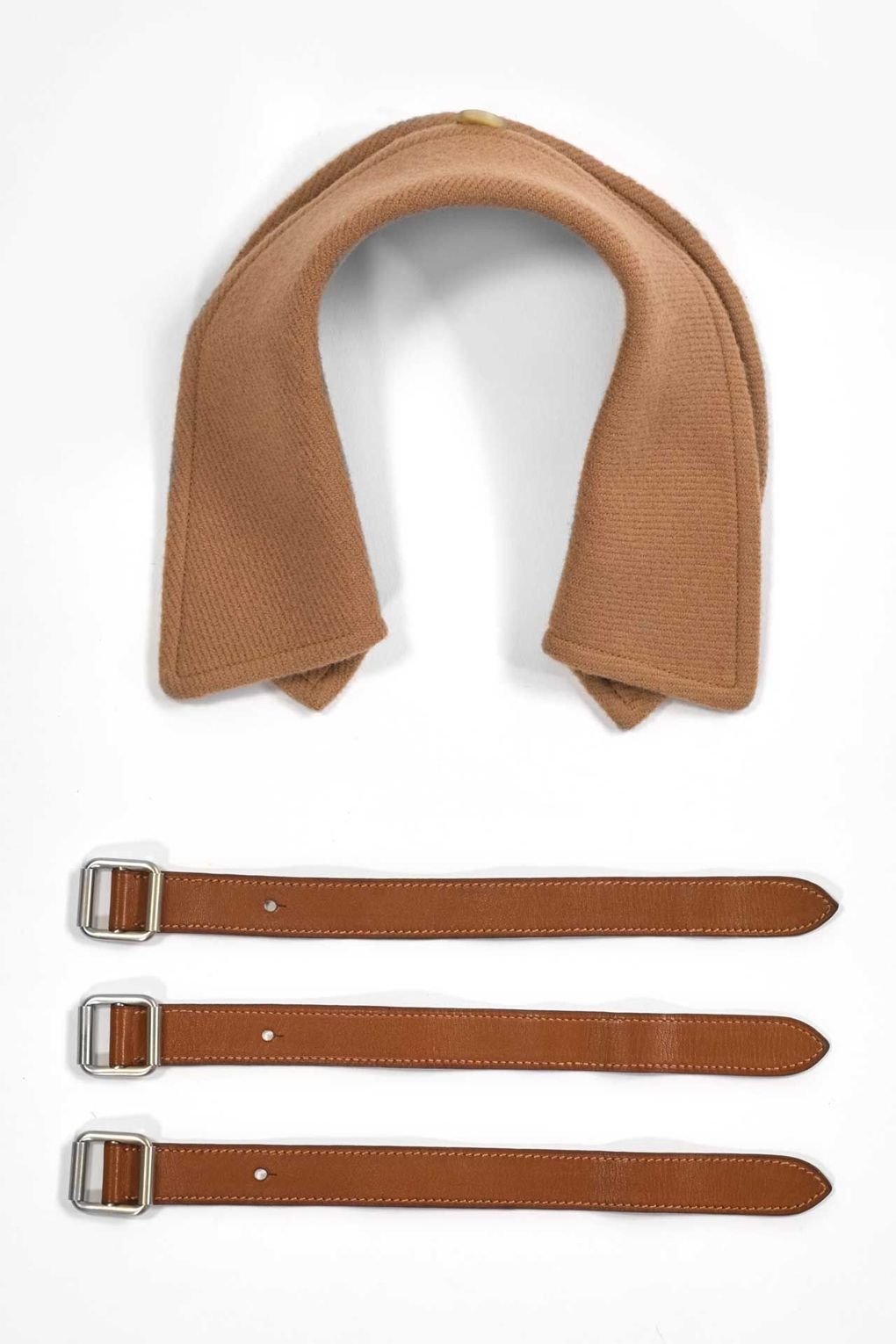 Martin Margiela for Hermès A/W 2000-2001: ‘Les Transformables’ accessories. Photo: Stany Dederen  Martin Margiela for Hermès A/W 2002-2003: ‘Sac initale’ in black leather from ‘Les Gestuelles’. Photo: Marina Faust 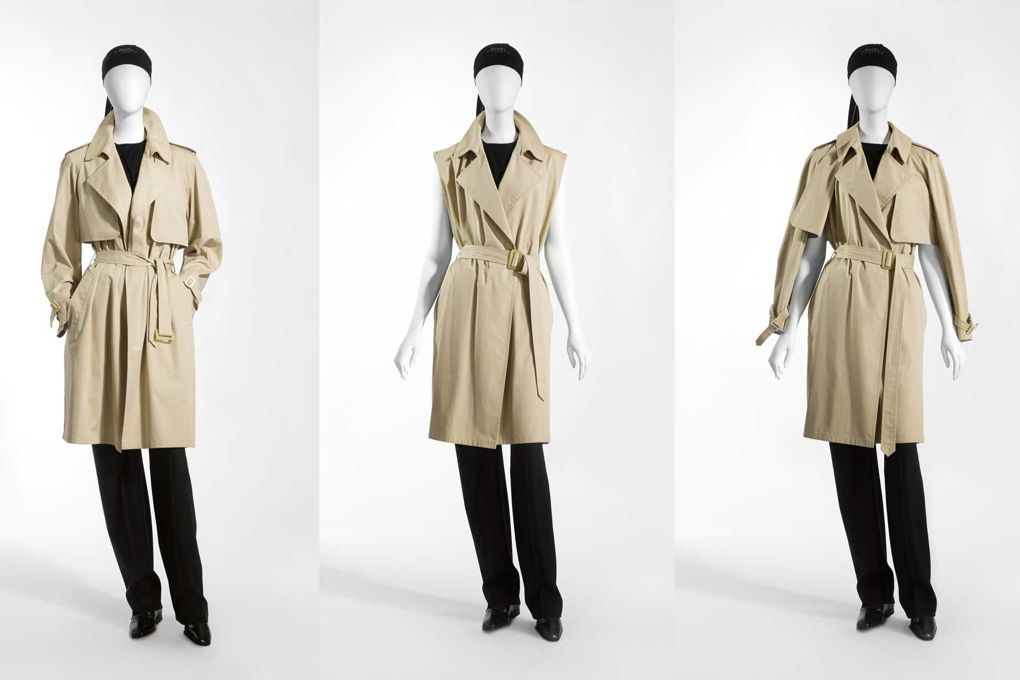 Martin Margiela for Hermès S/S 2003: trenchcoat in cotton gabardine, sleeveless pullover in cashmere and silk, pants in wool, ankle boots in leather, and ‘Losange’ headscarf in silk crêpe. Photo: Stany Dederen 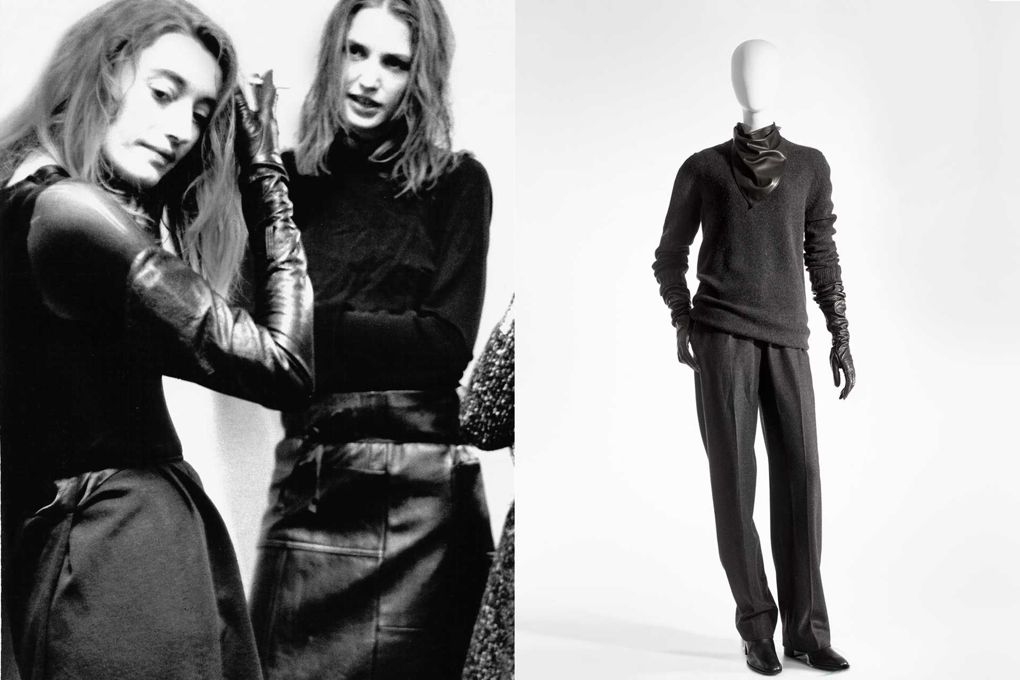 Left, Maison Martin Margiela A/W 1992-1993. Photo: Marina Faust. Right, Martin Margiela for Hermès A/W 2002-2003: tunic pullover in cashmere, pants in cashmere flannel, scarf in lambskin, ankle boots and gloves in leather. Photo: Stany Dederen 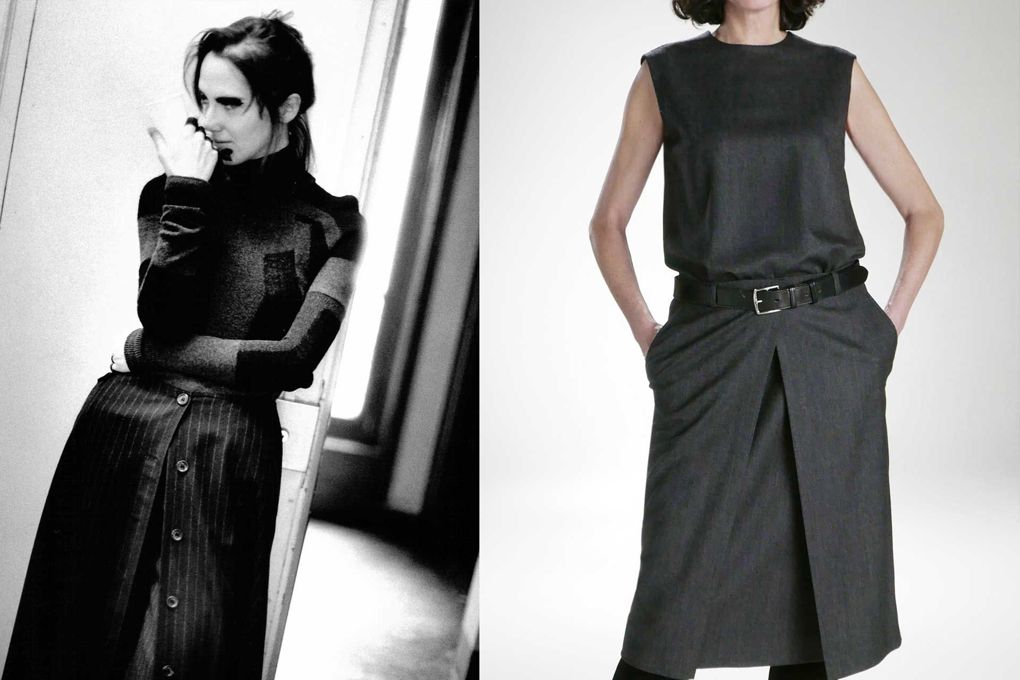 Left, Maison Martin Margiela A/W 1991-1992. Photo: Marina Faust. Right, Martin Margiela for Hermès A/W 2002-2003: ‘Les Gestuelles’. Photo: Marina Faust 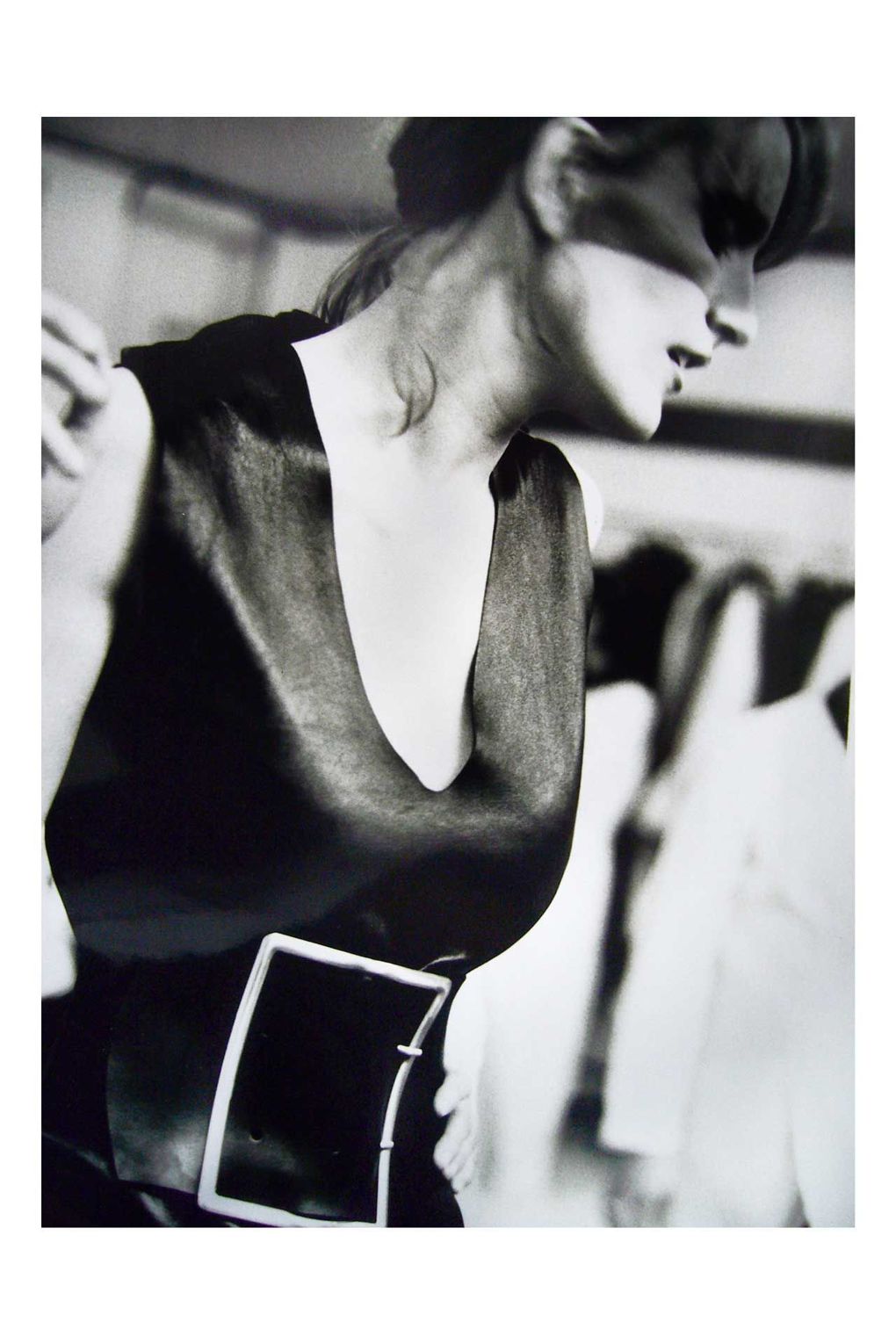 Maison Martin Margiela A/W 1996-1997. Photo: Marina Faust 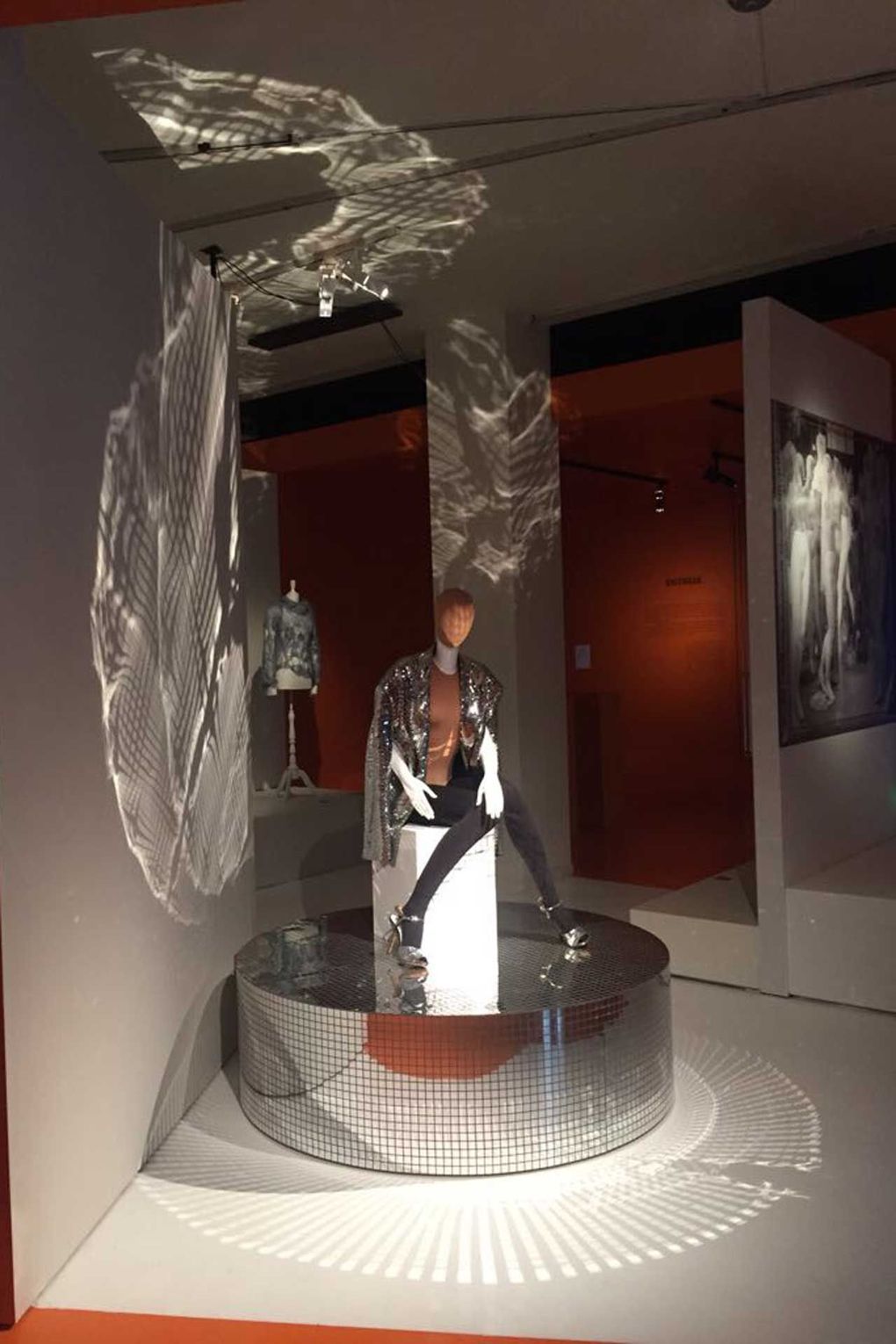 A display from the Martin Margiela exhibition at MoMu in Antwerp. Photo: @SuzyMenkesVogue 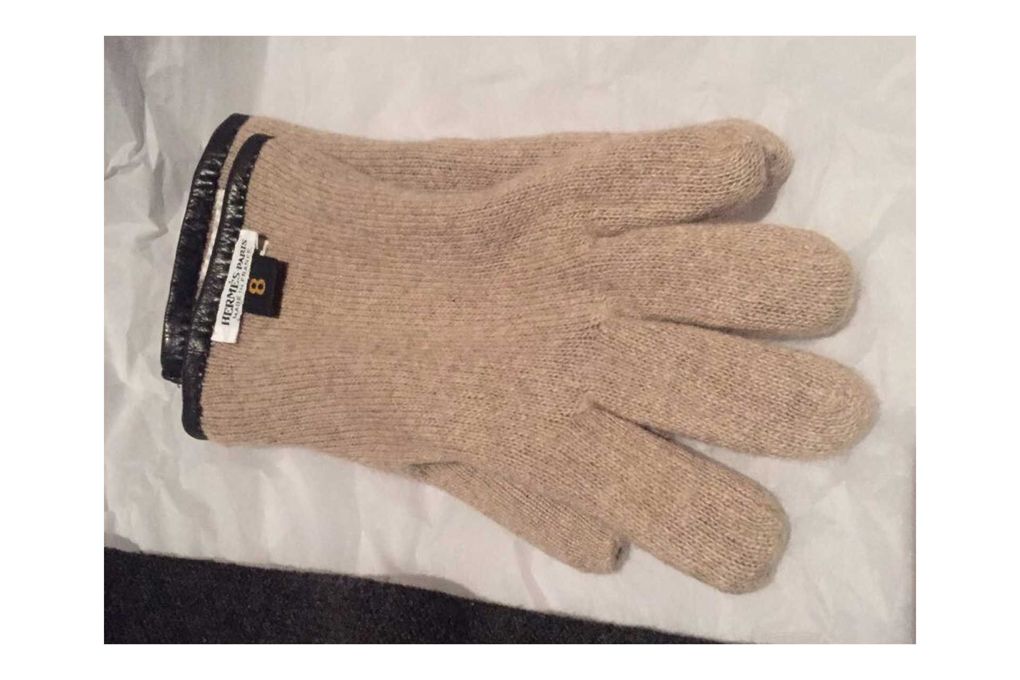 When Martin Margiela found these cashmere gloves in the Hermès archive, their identity tag inspired him to redesign the branding for the house. Photo: @SuzyMenkesVogue 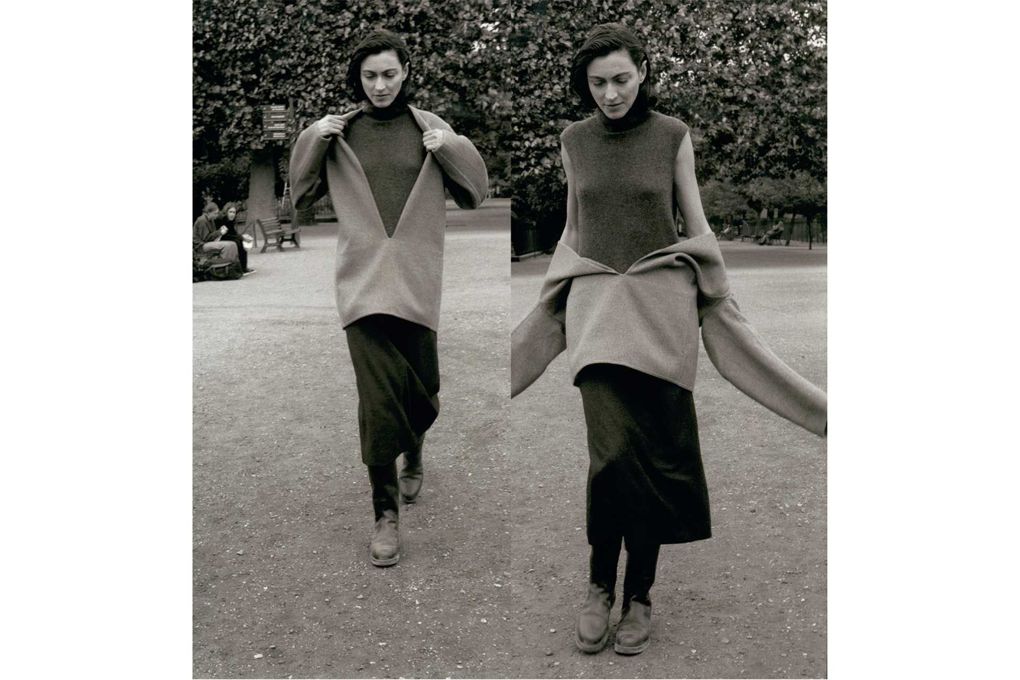 Martin Margiela for Hermès A/W 1998-1999: Vareuse in double-faced cashmere, sleeveless high-neck pullover in cashmere, mid-length skirt in Shetland wool and boots in calfskin, ‘Le vêtement comme manière de vivre’ for 'Le Monde d’Hermès' Credit John Midgley  Left, Martin Margiela for Hermès, L/Z 2000: ‘Le porte vêtement'. Photo: Monica Ho. Right, the jacket wrapped up like a picnic blanket on the catwalk. Photo: Marina Faust 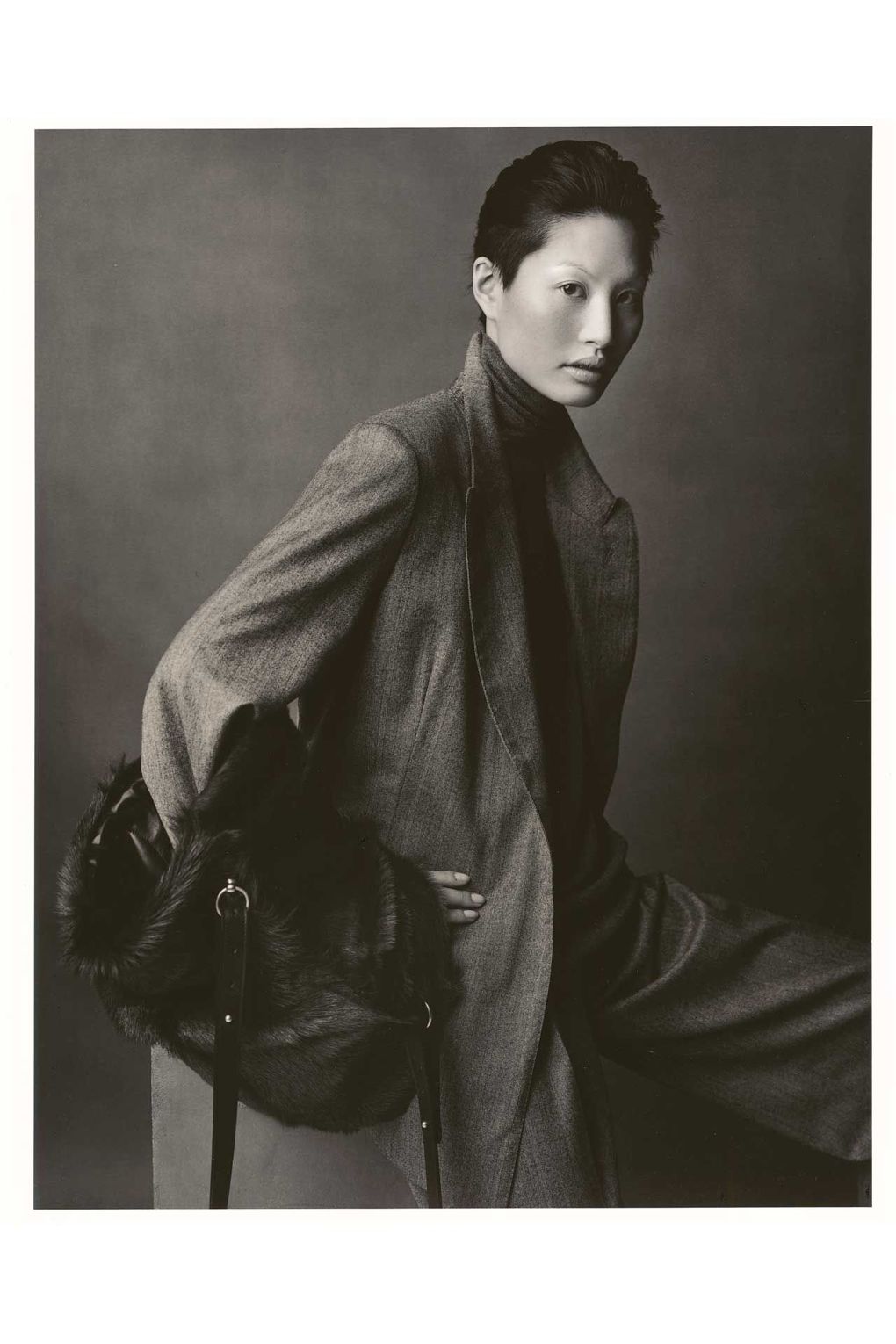 Martin Margiela for Hermès A/W 2001-2002: double-breasted jacket and pants in wool, sleeveless high-neck pullover in cashmere and silk, and muff in kidskin and lambskin, from 'Le Monde d’Hermès'. Photo: Ralph MeckY 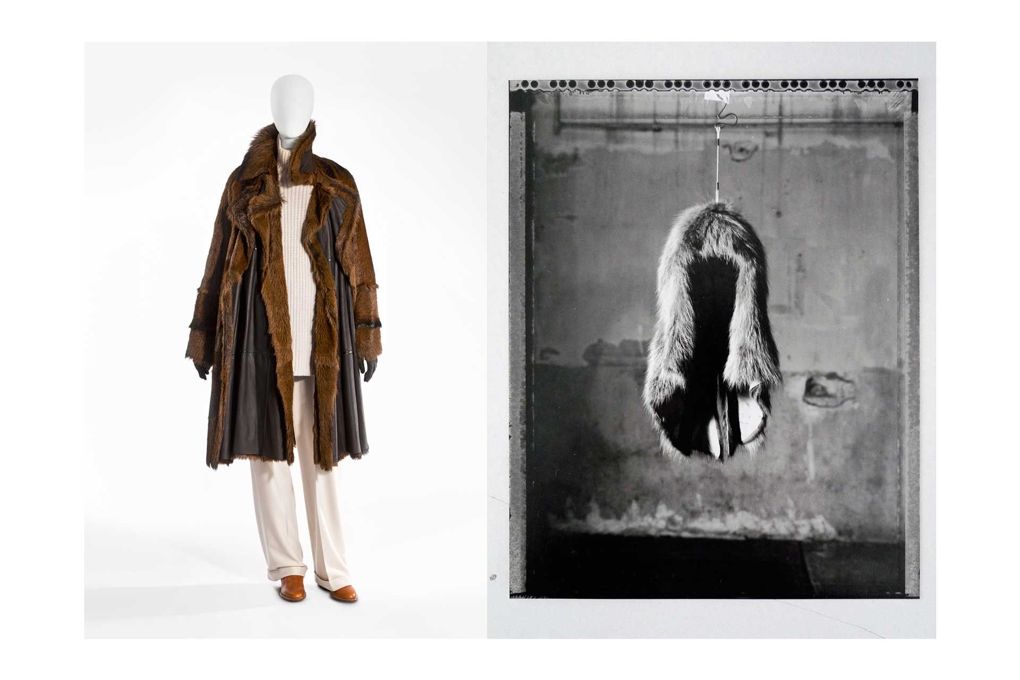 Left, Martin Margiela for Hermès A/W 2001-2002: coats worn two by two in kidskin, high-neck tunic pullover in cashmere, pants in cashmere flannel, riding boots and gloves in leather. Photo: Stany Dederen. Right, Maison Martin Margiela A/W 1997-1998. Photo: Marina Faust 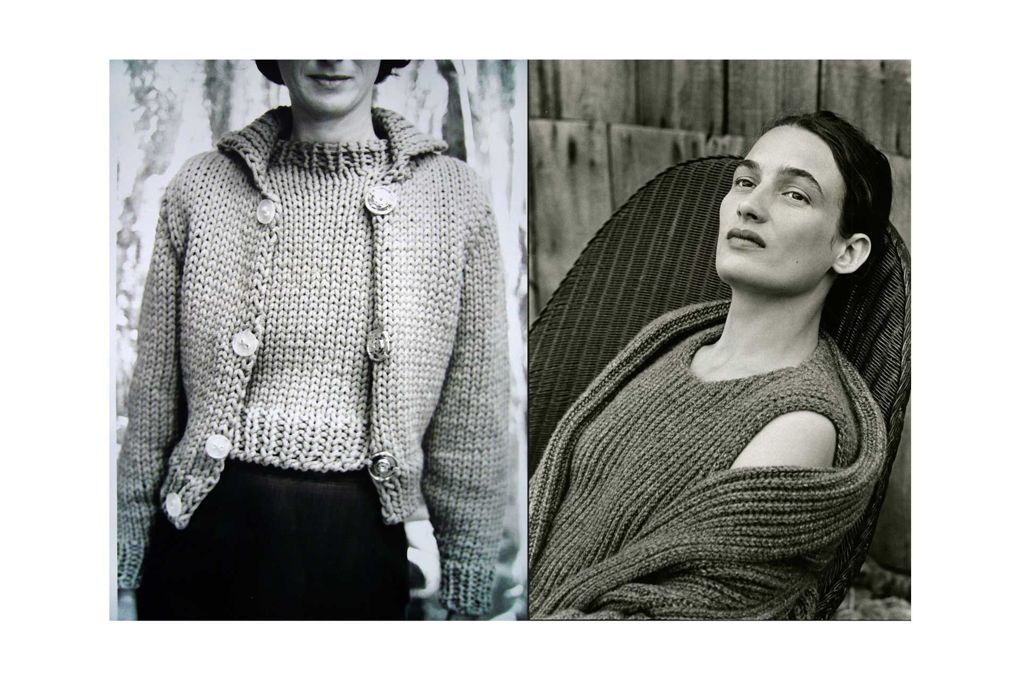 Left, Maison Martin Margiela, A/W 1994-1995. Photo: Marina Faust. Right, Hermès A/W 1999-2000: shawl-collar cardigan and sleeveless tunic pullover in cashmere, 'Portraits de femme en Hermès', Le Monde d’Hermès; model: Marie-Anne Van der Plaetsen. Photo: Joanna Van Mulder 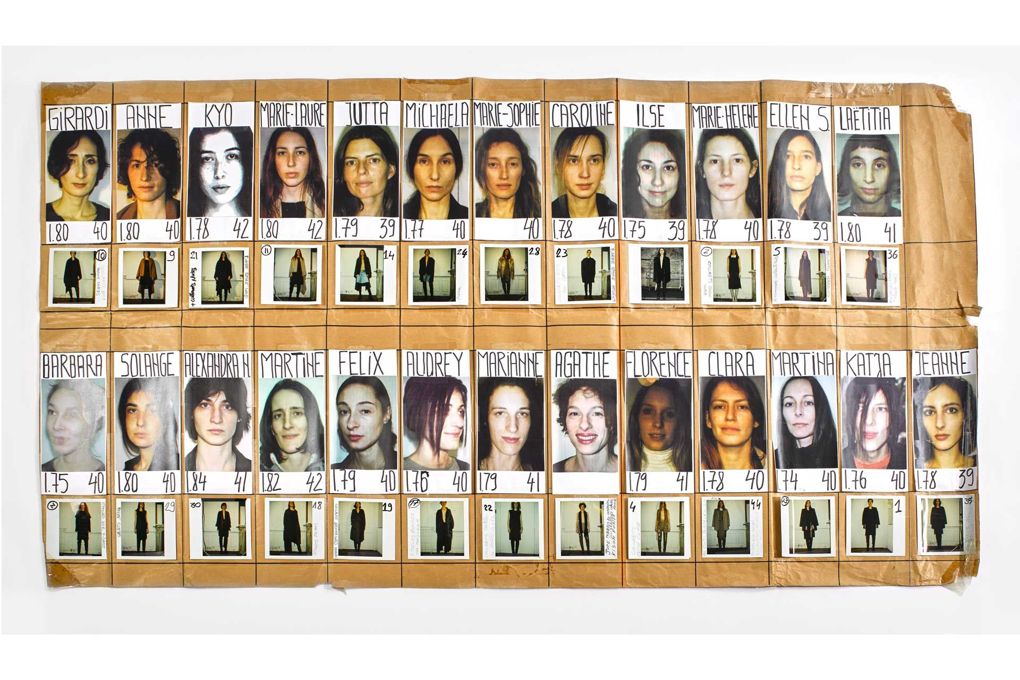 The casting sheet for Maison Martin Margiela A/W 2001-2002. Photo: Stany Dederen 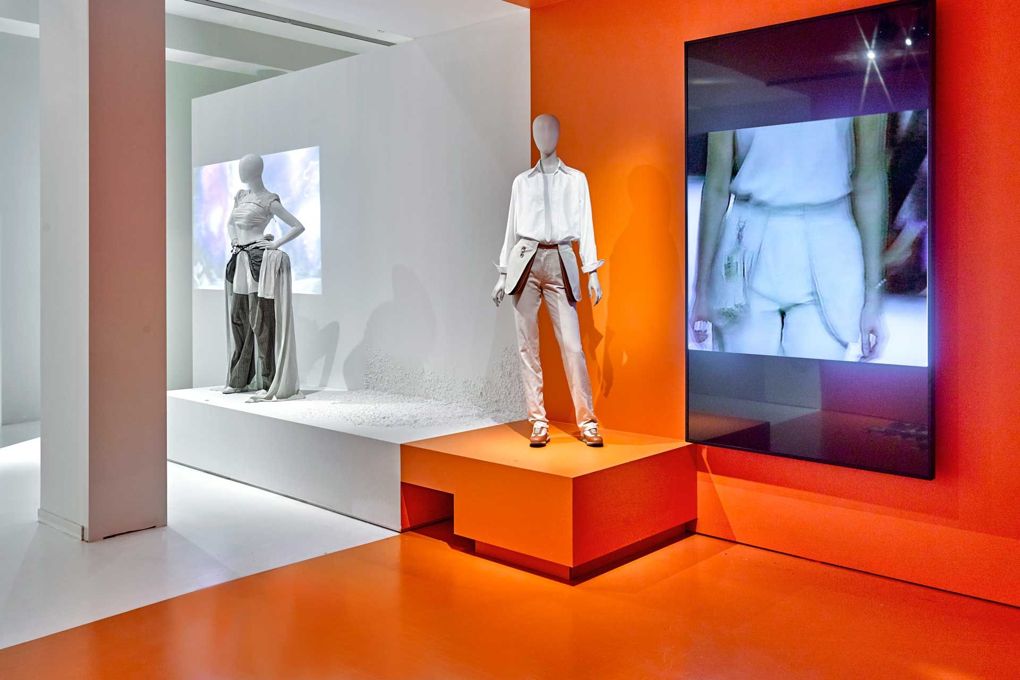 The exhibition displays Maison Margiela's innovations (left) alongside his looks for Hermès, revealing how the one influenced the other. Photo: Stany Dederen Credit Stany Dederen (责任编辑:admin) |
